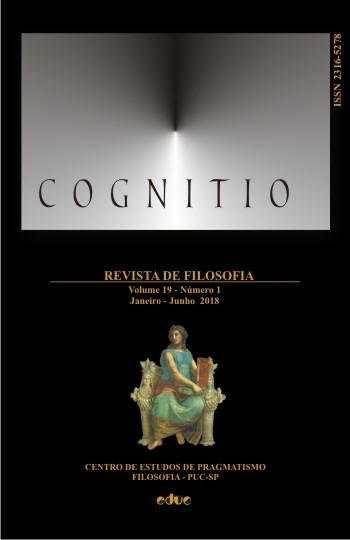Entre o pragmatismo e a animal linguístico
DOI:
https://doi.org/10.23925/2316-5278.2018v19i1p133-147Palavras-chave:
Charles Taylor, Natureza constitutiva da linguagem, John Dewey, Liminaridade, Omnipresença da linguagem, Autodescrição e auto interpretação.Resumo
Este artigo compara e contrapõe a abordagem naturalista pragmatista para a peculiaridade da linguagem, exemplificada, principalmente, mas, não exclusivamente, por John Dewey, com a extensa abordagem de Charles Taylor em seu O animal linguístico. Taylor, inspirado pelas obras de Hamann, Herder, e Humboldt, conta com recursos filosóficos e conceituais diferentes para o delineamento do que ele denomina de ‘a forma’ da capacidade linguística humana. Porém, Dewey e Taylor chegam a posições que se sobrepõem sem se identificar: a linguagem é a característica definidora constitutiva dos seres humanos. Seres humanos são definidos pelo surgimento da ‘como’ consciência, uma ‘ruptura’ em nossa imersão imediata no mundo, e, como Peirce e Dewey mostraram de maneira tão lúcida, um reflexivo estar consciente do uso de signos e sistemas de signos de todos os tipos. Esses sistemas potencializam e transformam nosso acesso ao mundo e a nós mesmos. Eles não apenas rotulam um mudo já existente. Eles criam âmbitos de significados e valores que não surgiram sem eles. A distinção crucial de Taylor entre os modelos designativo e constitutivo da linguagem é apoiada plenamente pela consideração pragmatista da linguagem, a qual Taylor não declara. Essa distinção mostrará ser de importância especial para Dewey e Taylor na criação de paisagens existencialmente vitais de significado incorporados nas autodescrições e nas práticas delicadas das artes de auto-reflexão. Tanto Dewey quanto Taylor mostram que assim como as texturas abertas da experiência crescem por suas extremidades, assim a própria linguagem possui sua própria “extremidade” e nos aponta para os domínios “liminares” que sustentam o limiar do sentido para além do totalmente dizível. Esses domínios, que eles mostram de maneiras diferentes mas complementares, são acessados como realidades por formas não discursivas que abrangem as obras de arte, o que Taylor denomina de ‘representações,’ e rituais performativos e restaurativos, tanto pessoais, cívicos e religiosos que incorporam os significados. Dewey e Taylor, divergem, entretanto, sobre se e de que maneira estes domínios precisam transcender a natureza.Downloads
Publicado
2018-09-06
Como Citar
Innis, R. E. (2018). Entre o pragmatismo e a animal linguístico. Cognitio: Revista De Filosofia, 19(1), 133–147. https://doi.org/10.23925/2316-5278.2018v19i1p133-147
Edição
Seção
Artigos Cognitio









